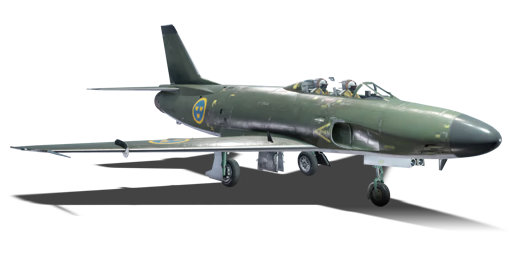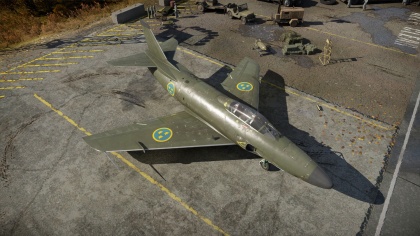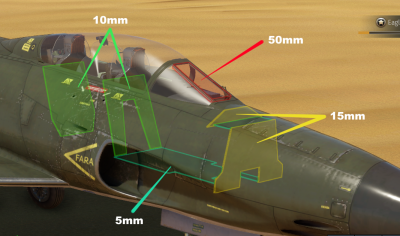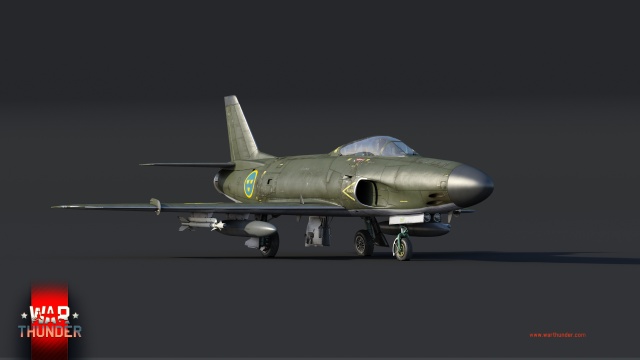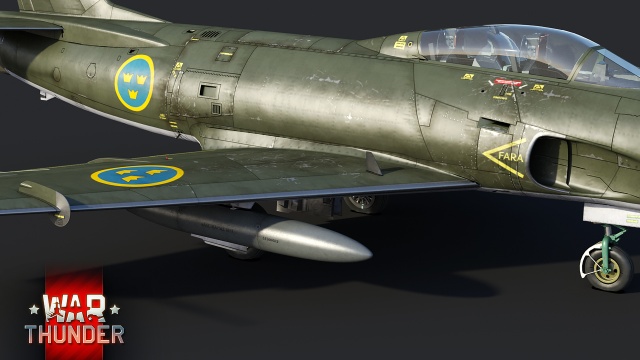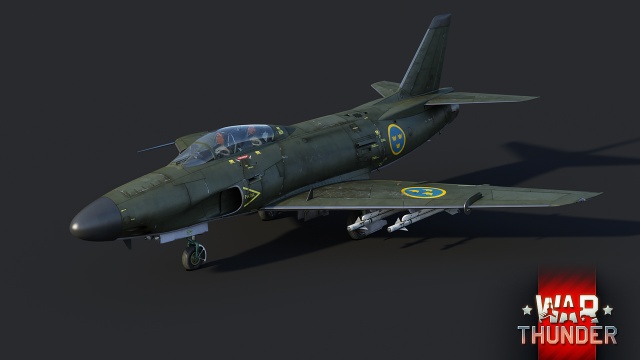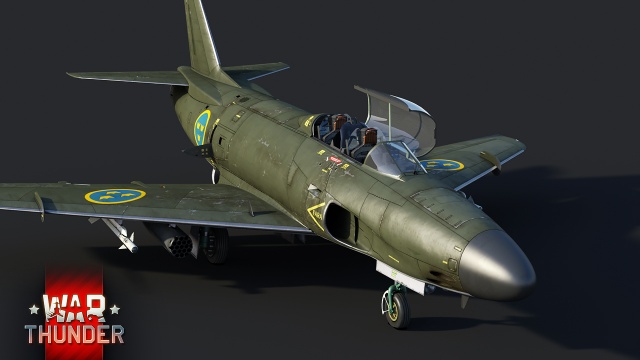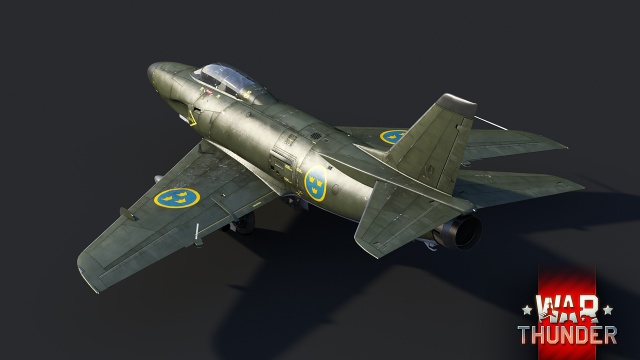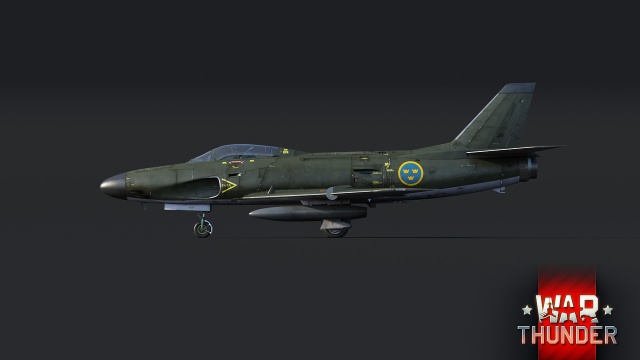Difference between revisions of "J32B"
(Added devblog images) |
Gentlespie (talk | contribs) (Changed some plane characteristics like thrust and weight using datamined statistics) (Tag: Visual edit) |
||
| Line 66: | Line 66: | ||
! Ailerons !! Rudder !! Elevators !! Radiator | ! Ailerons !! Rudder !! Elevators !! Radiator | ||
|- | |- | ||
| − | | < 850 || < | + | | < 850 || < 600 || < 600 || N/A |
|- | |- | ||
|} | |} | ||
| Line 89: | Line 89: | ||
! 8m fuel || 20m fuel || 28m fuel | ! 8m fuel || 20m fuel || 28m fuel | ||
|- | |- | ||
| − | | 1, | + | | 1,750 kg || colspan="2" | Afterburning axial-flow turbojet |
| − | | 9, | + | | 9,469 kg || 10,652 kg || 11,442 kg || 13,500 kg |
|- | |- | ||
! colspan="3" | {{Annotation|Maximum engine thrust @ 0 m (RB / SB)|The maximum thrust produced by each engine, while mounted in the aircraft. NOTE: Thrust varies significantly depending on speed & altitude.}} | ! colspan="3" | {{Annotation|Maximum engine thrust @ 0 m (RB / SB)|The maximum thrust produced by each engine, while mounted in the aircraft. NOTE: Thrust varies significantly depending on speed & altitude.}} | ||
| Line 98: | Line 98: | ||
! 8m fuel || 20m fuel || 28m fuel || MTOW | ! 8m fuel || 20m fuel || 28m fuel || MTOW | ||
|- | |- | ||
| − | | ''Stationary'' || 4, | + | | ''Stationary'' || 4,680 kgf || 6,739 kgf |
| − | | 0. | + | | 0.711 || 0.632 || 0.588 || 0.499 |
|- | |- | ||
| ''Optimal'' || 4,727 kgf<br />(0 km/h) || 7,199 kgf<br />(1,000 km/h) | | ''Optimal'' || 4,727 kgf<br />(0 km/h) || 7,199 kgf<br />(1,000 km/h) | ||
| − | | 0.76 || 0. | + | | 0.76 || 0.675 || 0.629 || 0.533 |
|- | |- | ||
|} | |} | ||
| Line 108: | Line 108: | ||
=== Survivability and armour === | === Survivability and armour === | ||
<!-- ''Examine the survivability of the aircraft. Note how vulnerable the structure is and how secure the pilot is, whether the fuel tanks are armoured, etc. Describe the armour, if there is any, and also mention the vulnerability of other critical aircraft systems.'' --> | <!-- ''Examine the survivability of the aircraft. Note how vulnerable the structure is and how secure the pilot is, whether the fuel tanks are armoured, etc. Describe the armour, if there is any, and also mention the vulnerability of other critical aircraft systems.'' --> | ||
| + | |||
* 5 mm steel plate - cockpit floor and spacer plate between frontal armour. | * 5 mm steel plate - cockpit floor and spacer plate between frontal armour. | ||
* 10 mm steel plate - behind the pilot and GIB's seats | * 10 mm steel plate - behind the pilot and GIB's seats | ||
| Line 121: | Line 122: | ||
The '''''{{PAGENAME}}''''' is armed with: | The '''''{{PAGENAME}}''''' is armed with: | ||
| + | |||
* 4 x 30 mm Akan m/55 cannons, nose-mounted (90 rpg = 360 total) | * 4 x 30 mm Akan m/55 cannons, nose-mounted (90 rpg = 360 total) | ||
| Line 128: | Line 130: | ||
The '''''{{PAGENAME}}''''' can be outfitted with the following ordnance: | The '''''{{PAGENAME}}''''' can be outfitted with the following ordnance: | ||
| + | |||
* Without load | * Without load | ||
* 38 x srak m/57B rockets | * 38 x srak m/57B rockets | ||
| Line 179: | Line 182: | ||
'''Pros:''' | '''Pros:''' | ||
| + | |||
* Excellent top speed. Will out-run almost every other jet at its BR range | * Excellent top speed. Will out-run almost every other jet at its BR range | ||
* 4x 30mm Akan M/55 that inflict devastating damage | * 4x 30mm Akan M/55 that inflict devastating damage | ||
| Line 191: | Line 195: | ||
'''Cons:''' | '''Cons:''' | ||
| + | |||
* Very poor turn-rate at high speeds. | * Very poor turn-rate at high speeds. | ||
* Mediocre manoeuvrability, almost every opponent it faces can out-manoeuvre it | * Mediocre manoeuvrability, almost every opponent it faces can out-manoeuvre it | ||
| Line 207: | Line 212: | ||
== Media == | == Media == | ||
<!-- ''Excellent additions to the article would be video guides, screenshots from the game, and photos.'' --> | <!-- ''Excellent additions to the article would be video guides, screenshots from the game, and photos.'' --> | ||
| + | |||
;Images | ;Images | ||
<gallery mode="packed"> | <gallery mode="packed"> | ||
| Line 222: | Line 228: | ||
== See also == | == See also == | ||
''Links to the articles on the War Thunder Wiki that you think will be useful for the reader, for example:'' | ''Links to the articles on the War Thunder Wiki that you think will be useful for the reader, for example:'' | ||
| + | |||
* ''reference to the series of the aircraft;'' | * ''reference to the series of the aircraft;'' | ||
* ''links to approximate analogues of other nations and research trees.'' | * ''links to approximate analogues of other nations and research trees.'' | ||
| Line 236: | Line 243: | ||
* ''encyclopedia page on the aircraft;'' | * ''encyclopedia page on the aircraft;'' | ||
* ''other literature.'' --> | * ''other literature.'' --> | ||
| + | |||
* [[wt:en/news/6519-development-j32-lansen-flying-lance-en|[Devblog] J32 Lansen: Flying Lance]] | * [[wt:en/news/6519-development-j32-lansen-flying-lance-en|[Devblog] J32 Lansen: Flying Lance]] | ||
{{AirManufacturer Saab}} | {{AirManufacturer Saab}} | ||
{{Sweden jet aircraft}} | {{Sweden jet aircraft}} | ||
Revision as of 07:08, 21 April 2020
Contents
| This page is about the Swedish jet fighter J32B. For the attack-oriented version, see A32A. |
Description
The J32B Lansen is a rank VI Swedish jet fighter
with a battle rating of 9.7 (AB/SB) and 9.3 (RB). It was introduced in Update 1.95 "Northern Wind".
General info
Flight performance
Describe how the aircraft behaves in the air. Speed, manoeuvrability, acceleration and allowable loads - these are the most important characteristics of the vehicle.
| Characteristics | Max Speed (km/h at 0 m - sea level) |
Max altitude (metres) |
Turn time (seconds) |
Rate of climb (metres/second) |
Take-off run (metres) | |||
|---|---|---|---|---|---|---|---|---|
| AB | RB | AB | RB | AB | RB | |||
| Stock | 1,133 | 1,128 | 12500 | 34.4 | 34.6 | 84.5 | 78.5 | 900 |
| Upgraded | 1,148 | 1,140 | 33.6 | 34.0 | 119.5 | 101.0 | ||
Details
| Features | |||||
|---|---|---|---|---|---|
| Combat flaps | Take-off flaps | Landing flaps | Air brakes | Arrestor gear | Drogue chute |
| ✓ | ✓ | ✓ | ✓ | X | X |
| Limits | ||||||
|---|---|---|---|---|---|---|
| Wings (km/h) | Gear (km/h) | Flaps (km/h) | Max Static G | |||
| Combat | Take-off | Landing | + | - | ||
| 1160 | 450 | 550 | 550 | 320 | ~10 | ~4 |
| Optimal velocities (km/h) | |||
|---|---|---|---|
| Ailerons | Rudder | Elevators | Radiator |
| < 850 | < 600 | < 600 | N/A |
Engine performance
| Engine | Aircraft mass | |||||
|---|---|---|---|---|---|---|
| Engine name | Number | Empty mass | Wing loading (full fuel) | |||
| Svenska Flygmotor RM6A | 1 | 8,680 kg | 307 kg/m2 | |||
| Engine characteristics | Mass with fuel (no weapons load) | Max Takeoff Weight | ||||
| Weight (each) | Type | 8m fuel | 20m fuel | 28m fuel | ||
| 1,750 kg | Afterburning axial-flow turbojet | 9,469 kg | 10,652 kg | 11,442 kg | 13,500 kg | |
| Maximum engine thrust @ 0 m (RB / SB) | Thrust to weight ratio @ 0 m (WEP) | |||||
| Condition | 100% | WEP | 8m fuel | 20m fuel | 28m fuel | MTOW |
| Stationary | 4,680 kgf | 6,739 kgf | 0.711 | 0.632 | 0.588 | 0.499 |
| Optimal | 4,727 kgf (0 km/h) |
7,199 kgf (1,000 km/h) |
0.76 | 0.675 | 0.629 | 0.533 |
Survivability and armour
- 5 mm steel plate - cockpit floor and spacer plate between frontal armour.
- 10 mm steel plate - behind the pilot and GIB's seats
- 15 mm steel plate - armour plates in front of the cockpit section
- 50 mm bulletproof glass - armoured canopy windscreen
The aircraft provides good pilot protection with steel plates and bulletproof glass.
Armaments
Offensive armament
The J32B is armed with:
- 4 x 30 mm Akan m/55 cannons, nose-mounted (90 rpg = 360 total)
Suspended armament
The J32B can be outfitted with the following ordnance:
- Without load
- 38 x srak m/57B rockets
- 4 x Rb24 missiles
- 2 x Rb24 missiles + 38 x srak m/57B rockets
Usage in battles
This aircraft excels at being fast, it is important to use that advantage to quickly Boom & Zoom any unsuspecting enemies. Avoid utilising turning manoeuvres with other aircraft as every aircraft with the exception of the F-100D will shake you rather easily and you risk being pulled into a "reversal". Although you can easily out-run most jets, some aircraft like the Etendard IVM, MiG-17AS and Shenyang F-5 will easily catch up. These aircraft prove deadly to the J32B as they will keep up with your turns if you try to evade them, not to mention they also carry air-to-air missiles which they will certainly use to force you to bleed speed (if you don't get destroyed in the process). Your safest bet is to go in a straight line hugging the maximum safe speed (concern for realistic and simulator battles) and hope they pull away.
Modules
| Tier | Flight performance | Survivability | Weaponry | ||
|---|---|---|---|---|---|
| I | Fuselage repair | Offensive 30 mm | |||
| II | Compressor | Airframe | m/57 | ||
| III | Wings repair | Engine | New 30 mm cannons | ||
| IV | G-suit | Cover | Rb24 | ||
Pros and cons
Pros:
- Excellent top speed. Will out-run almost every other jet at its BR range
- 4x 30mm Akan M/55 that inflict devastating damage
- 4x Rb-24 air-to-air missiles, same performance as AIM-9Bs
- Powerful afterburning engine, providing excellent acceleration
- Integrated radar
- Slightly above average roll-rate
- Resistant to high-G manoeuvres (up to 10Gs)
- Decent pilot protection and airframe endurance
- Great energy retention
- Fowler flap design provides excellent lift at low speeds
Cons:
- Very poor turn-rate at high speeds.
- Mediocre manoeuvrability, almost every opponent it faces can out-manoeuvre it
- Very low extended gear rip speed (ensure gear is raised right after take-off and lowered at a safe speed)
- Sluggish at slow speeds
- Very inefficient and small air-brake design, requires high angle-of-attack or aggressive banking to bleed excess speed quickly
- Relatively large target
- High rate of fire means the ammunition will deplete very quickly, trigger control required
History
In the year 1948, SAAB started to develop a new type of multi purpose aircraft with capabilities such as a strike-fighter, interceptor or reconnaissance aircraft. The project was called P1150 and had the intent to replace the B18, J21A, A21R and the J30 aircraft. After some testing, a swept wing design typical for the time period was decided upon. After some testing with a Swedish jet engine design called the Dovern, it was decided that the engine lacked the desired power so a swap to the British Rolls-Royce Avon Mk.21 engine was decided upon due to its ability to produce more power without its afterburner on than the Dovern could even with the afterburner engaged. The airplane was designated the Saab 32 Lansen and flew for the first time in November 1952 with Bengt Olow as pilot.
A total of 447 aircraft were delivered to the Swedish Air Force from 1955 until 1960. These were modified and renovated until its retirement in 1997. A total of 10 variants were in service, including the prototype P1150.
Media
- Images
- Videos
See also
Links to the articles on the War Thunder Wiki that you think will be useful for the reader, for example:
- reference to the series of the aircraft;
- links to approximate analogues of other nations and research trees.
External links
| Swedish Aeroplane Company Ltd. (SAAB) | |
|---|---|
| Pre-SAAB: SA / ASJA | |
| SA 'Jaktfalken' | J6B |
| SAAB 17 | B17A · B17B · S17BS |
| SAAB 18 | B18A · B18B · T18B · T18B (57) |
| SAAB 21 | J21A-1 · J21A-2 · A21A-3 · J21RA · A21RB |
| SAAB 29 'Tunnan' | J29A · A29B · J29D · J29F |
| SAAB 32 'Lansen' | J32B · A32A · A32A Röd Adam |
| SAAB 35 'Draken' | J35A · J35D |
| SAAB 37 'Viggen' | JA37C · JA37D · JA37DI · JA37DI F21 · AJ37 · AJS37 |
| SAAB 39 'Gripen' | JAS39A · JAS39C |
| SAAB 105 | SK60B · SAAB-105G |
| License Production | B3C (Ju 86K) |
| Export | SAAB-105OE · J35XS · ▄JAS39C · ◔JAS39EBS HU C |
| Sweden jet aircraft | |
|---|---|
| Fighters | J21RA |
| J29A · A29B · J29D · J29F | |
| J32B | |
| J34 | |
| J35A · J35D | |
| JA37C · JA37D · JA37DI · JA37DI F21 | |
| JAS39A · JAS39C | |
| Strike aircraft | A21RB |
| A32A · A32A Röd Adam | |
| A28B | |
| AJ37 · AJS37 | |
| SK60B · SAAB-105G | |
| Export | SAAB-105OE |
| Finland | ▄Vampire FB 52A · ▄MiG-21bis · Saab J35XS |


